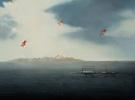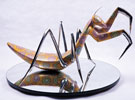Oops, Stepped Over the Line
----The World and Inner Vision of Luo Xu
By describing an individual as exotic and different, critics often show the disturbance in the subject. Such comments not only proposed limited recognition and appreciation, but also explicitly expose the guarded stance. By exaggerating the particularity and singularity, the commentator succeeds to exclude the object or the person from public attention and discussions; thus, hides away the impotence and anomie of the common language. In fact, when a person or an object interferes with our conventional understanding of the world and our time, before they are truly accepted, the common language more or less isolates them; and furthermore, deprives their “right” to participate. As a result, these words form an isolation screen through exaggeration. Although certain statements are emphasized as compliments, the persistent silence lies underneath.
For a long time, artist Luo Xu appears as the focus of this scenario. It has been 16 years since he first interested the world in the Aboriginal Nest. During the years, both sincere interst and hostile satire show up in the critiques of him and his work. Apart from rare exceptions of serious commentators such as the American critic Barbara Pollack, others have agreed on the vocabulary for describing Luo Xu. It is also disturbing to see how Luo is surrounded by a collection of landscape terms and exotic descriptions due to his Yunnan background and legendary experiences. These comments, in many occasions, took the place of serious pondering over the significance of Luo Xu and his work in the contemporary context.
Under these circumstances, trying to arrange a grand and glorifying genre for Luo Xu with the Art History terminology, even the fairest critic has to refer to words such as Surrealism, Realism, Magic Realism, bohemian and pop art. However, when looking back upon his artist career, Luo himself said, “I love crossing the line.” “Crossing the line ” characterizes him as a force that escapes from and exists outside of the terminology. He never conforms to the categorizing criteria. Neither will he ever show the slightest interest in becoming the taker of the proposed actions. Nevertheless, his integration of art and life stands foremost against such scholastic operation. Here art and life are so intricately intertwined that a forced separation will only lead to destruction.
Aware of the paradox and problem mentioned above, an appropriate solution might lead to abandoning the guarded vocabulary that coins the artist as different. At the same time, closet the arms of Art History, feel his art with your body instead of inspirations, appreciate the human subject rather than a historical context. Faced with the world and inner vision created by Luo Xu, we need to enter his world. It is far from enough to simply play safe and observe from the academic reign, attempting accurate aims without any cost.
The Nest: Siege and Escape
When looking back upon his experience, we need to put aside his legendary early years and directly confront his self-awareness of being an artist, which reveals to us the importance of the Aboriginal Nest. In other words, the beginning of the construction in 1996 was a decisive turning point in both his life and his art career. The unique architecture complex not only combines his early experiences as a construction worker, a porcelain factory worker, an art apprentice and a broke businessman, but also reflects his life motivation—marriage, family, and his son Luo Mansi. The architectural complex contributed to an informal marriage between life and artistic creation. He has to face the 12-acre work all by himself. He preserves and maintains it, and at the same time consolidates and develops his relationship with the piece. Indeed, this marriage seems more vivid and sincere than human marriage. Luo Xu not only has to bear the burden of practical issues brought by this gigantic work such as debt, controversy, management, etc, he is also forced to confront the pain triggered as he dedicate his mind and body to the work. Any temporary delight is followed by the great solitude that surrounds the artist with desolation. The emotion is so strong that it fills every single corner of the individual structures. As the artist evokes the emotion, Luo is bound to confront it, which eventually suffocates him.
The informal marriage between life and art has brought the artist numerous gifts, and vice versa. Luo created the early work, The Board (1998) to relieve the gloomy solitude. Later, he sculpted the models that eventually evolved into The Choir (1999-2001). The works that scattered around the Aboriginal Nest are also fruits of the marriage, such as 99th Flood Peak(1998), Prayer at Dawn (1998), Versatile Bag (1998), Calla and Tulip (1998), etc. Works from this period predicted the fundamental elements of his art done in the following decade. More importantly, after sweat and tears, Luo Xu achieved spiritual salvation through the later works that were developed from these basic elements. His sense of belonging to the Aboriginal Nest is thus enhanced.
As we take these into account, including his marriage with the “bride” that he summoned from the red earth, it is now easy to understand why works from this period appear to be so perfect and striking in the Aboriginal Nest, and yet lifeless and out of place in public spaces such as galleries and museums. Although the possibilities and misconceptions of words may stimulate some different energy, they are never as lively as in the Aboriginal Nest. They belong here, just like the luxuriant vegetation in the Nest. Including his fostered “brother” Luo Hui (a mule), they serve as his marriage vow to the land, the mother of the Aboriginal Nest, and a firm symbol of the unstable relationship.
In this game of siege and escape, The Choir is undoubtedly the most astounding masterpiece of Luo Xu. Apart from the numerous components and the enormous scale, the moment when we enter the designated exhibition room in the sprinkling light, we are already impressed by the songs and poems performed by the silent phalanx of ceramic sculptures. Even Carmina Burana, though chosen by the artist to accompany the work, becomes unnecessary. However, when we learned that the singing and murmuring choir members were born out of the overwhelming solitude Luo Xu experienced in 1999 and that the assemblage of the piece continued until 2002, the voices no longer solely fill the space but also extend in time. As far as the author knows, the strong emotion installation is unparalleled in Chinese contemporary art. Considering the nature of installation and its continuity, the only possible match for the work are the outstanding churches from the Middle Ages.




